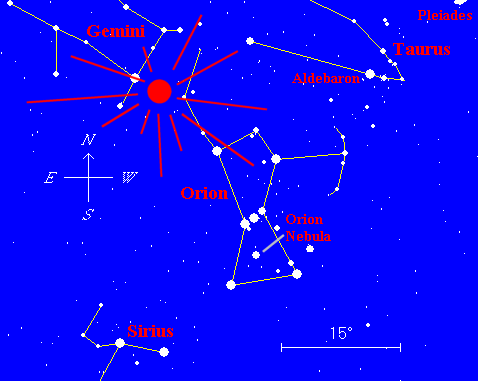It’s not often that both hemispheres of the Earth get treated to an annual meteor shower, but in a matter of hours the complex Orionid stream is heading to dark sky your way! Where and when do you watch? Will it be as good as this year’s Perseids as filmed by John Chumack above? Try even better! Follow me…
We are now slipping into the stream of Comet Halley and one of the finest meteor showers of the year. If skies are clear tonight, this would be the perfect chance to begin observations of the Orionid meteor shower. But get to bed early and rise well before dawn to enjoy one of the year’s most reliable meteor showers. The offspring of Comet Halley grace the early morning hours as they return as the Orionid meteor shower. This dependable shower produces an average of 10-20 meteors per hour maximum, and best activity begins before local midnight on the 20th, and reaches its peak as Orion stands high to the south about two hours before local dawn the 21st. With only the tiniest crescent of a Moon gone in the early evening, this looks to be the year’s premier meteor shower!
Although Comet Halley has now departed the inner Solar System, its debris trail remains well organized – allowing us to predict when this meteor shower will occur. The Earth first enters the stream at the beginning of October and does not leave until the beginning of November. This makes your chances of “catching a falling star” above average! These meteors are very fast, and although faint, occasional fireballs do leave persistent trails.
For best success, get away from city lights. Face south-southeast in the northern hemisphere and almost overhead in the southern – then relax and enjoy the stars of the Winter Milky Way. The radiant is near Betelguese, but may occur from any part of the sky. The meteor watching experience is much more comfortable if you include a lawn chair, blanket, and thermos of your favorite beverage.
Orionid Meteor Shower – Key Points
- The nights of October 21st and 22nd are the best times to watch.
- Maximum hours rates are typically 20/hr and meteors are described as “fast”.
- The radiant is at RA=06h20m, DEC=+16o, just above the left shoulder of Orion.
- The average magnitude of an Orionid meteor is 3.
Clouded out? Don’t despair. You don’t always need eyes or perfect weather to keep the watch. Tune an FM radio to the lowest frequency that doesn’t receive a clear signal. An outdoor FM antenna pointed to the zenith increases your chances – but isn’t essential. Simply turn up the static and listen. Those hums, whistles, beeps, bongs, and occasional snatches of signals are distant transmissions being reflected off a meteor’s ion trail!
Sky Chart Courtesy of NASA.


“Tune an FM radio to the lowest frequency that doesn’t receive a clear signal. An outdoor FM antenna pointed to the zenith increases your chances – but isn’t essential. Simply turn up the static and listen. Those hums, whistles, beeps, bongs, and occasional snatches of signals are distant transmissions being reflected off a meteor’s ion trail! ”
As a musician, I found that awesome. I bet I could score big points with the Terry Riley-loving crowd by recording that and turning into “tape music.”
Actually, I might do just that! I could really use a few points with some of my professors… 😀
good morning, all!
the orionids were a great success here in north-central ohio! observations yielded a count of 37 for a period of 150 minutes between 09:00 UT and 11:30 UT. the average magnitude ran between 3-2 and they were fast, FAST, FAST! most left about a 2 to 4 degree trail and some trails were very wide and persistent. one rather notable thing from my observing position was that around 75% of all the meteoric activity that i observed went through the constellation of gemini. yes, they appeared in other parts of the sky as well – but were more concentrated down a narrow path than i really expected. i also noticed they came in “flurries” spaced about 20-30 minutes apart instead of steady activity. the longest and most productive flurry occurred about 09:45 to 10:00 UT with a total of 17 during that 20 minute stretch.
while i was out, i also made a couple of other observations as well:
i hope that many of you also had a chance to observe and enjoy! if you didn’t have clear skies last night, try again over the next few days. the orionids won’t end for awhile yet and peak times aren’t always 100% accurate.
(pink? let me know if you had success in recording. i always turn on the garage radio when i observe, because it never ceases to fascinate me that it works!)
You See?!!
meteoman… i’ve had to delete your link because it called up pop-up pornographic photos and links. i am not a prude, but i cannot allow that where minors can access it.
please feel free to cut and paste your observations in!
Your German Shepherds sound like great astronomers, Tammy! I have two dogs myself but I bet they would only “observe” if it involved chasing tennis balls. 🙂
“(pink? let me know if you had success in recording. i always turn on the garage radio when i observe, because it never ceases to fascinate me that it works!)”
I plugged my headphones into my stereo and tuned it to unclear low frequencies- but I don’t think I have the right kind of reciever at all- mine only goes down to about 87.5 (around the normal commercial radio station’s amplitudes.) I heard plenty of noises in the static (they’re fun to listen to all on their own!) but I think they’re always there.
It really would be the perfect semi-avant-garde composition, though!